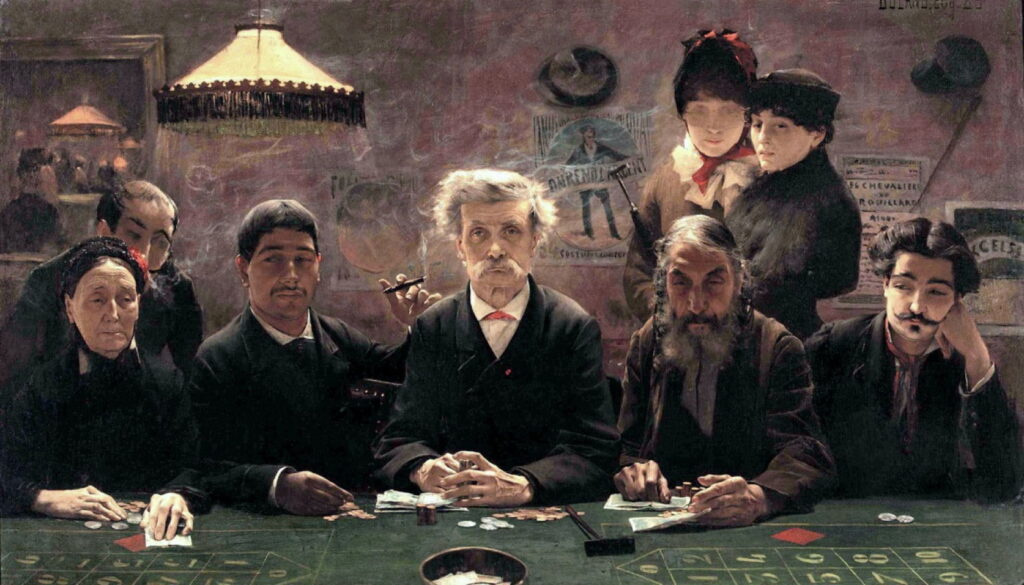Gambling in paint: Virtue

Prior to the middle of the nineteenth century, gambling had generally been depicted in painting as sinful, a step on the road to damnation, vulnerable to cheats and crooks, the preserve of the reckless, poor and despicable. Its narrative was that of ruin, not redemption. But there were a couple of exceptions.
Salvator Rosa (1615–1673), Soldiers Gambling (c 1656-58), oil on canvas, 77.1 x 61.6 cm, Dulwich Picture Gallery, London. Wikimedia Commons.
Salvator Rosa’s timeless version of Soldiers Gambling, from about 1656-58 illustrates the longstanding tolerance of minor gambling among soldiers. Change the dress, armour and weapons, and this could have been at almost any time in the last couple of millennia.
Strangely, the other exempted group were children, particularly young boys.
Bartolomé Esteban Murillo (1617–1682), Young Boys Playing Dice (c 1675), oil on canvas, 145 x 108 cm, Alte Pinakothek, Maxvorstadt, Germany. Wikimedia Commons.
Murillo’s Young Boys Playing Dice of about 1675 takes up a new theme, of gambling among the poor and vulnerable. Two scruffy urchins from the streets of Seville are throwing dice for the small piles of change which are probably their entire fortunes. A third stands over them, chewing at a bread roll while his dog looks up longingly at the food.
Albert Anker (1831–1910), Knucklebone Players (1864), media not known, 81 x 65 cm, Musée Gruérien, Bulle, Switzerland. Wikimedia Commons.
Albert Anker turns to classical times to put his spin on gambling games in his Knucklebone Players (1864). Three youths are here playing a game of greater skill, but which was still frequently the basis of gambling. The distinguished-looking men in the background are hardly the sort to frequent a gambling den, are they?
Eugène Siberdt (1851–1931), The Little Gamblers (1876), oil on canvas, 47.6 × 79.3 cm, Private collection. Wikimedia Commons.
Unlike Murillo’s young boys, those in Eugène Siberdt’s The Little Gamblers (1876) aren’t particularly poor, nor are they underprivileged. A satchel, open book and slate at the lower right confirm that at least one of them is attending school and literate, but they still engage in a game of cards in the afternoon sunshine.
It wasn’t until the middle of the nineteenth century that moralising paintings were done with, and some artists felt able to depict gambling in a more favorable light.
Eduard Swoboda (1814-1902), Va banque or Gambling (1849), oil on canvas, 94.5 x 126.5 cm, Österreichische Galerie Belvedere, Vienna, Austria. Wikimedia Commons.
Eduard Swoboda’s Va Banque or Gambling from 1849 shows a salon in which the card game of Pharo or Faro is being played by a group containing several women, and more respectable men too. The term vabanque or va banque refers to a player betting a sum equal to the size of the current bank, in an effort to gain the whole bank, or go bust in the process. Swoboda shows a moment when the bank is currently in the hands of the older man wearing a skullcap (presumably a kippah to indicate that he is Jewish) to the left of centre. The young woman wearing a white dress and standing to the right of centre is thinking about whether to vabanque against him.
Jean-Eugène Buland (1852–1926), Le Tripot (The Dive) (1883), oil on canvas, 63.5 × 109.2 cm, location not known. Wikimedia Commons.
Jean-Eugène Buland’sLe Tripot (The Dive) from 1883 is one of my favourite paintings, although it’s more ambivalent if accurate. Set in a seedy, downmarket gambling den, it’s a group portrait of five hardened gamblers at the table. Each is rich in character, and makes you wonder how they came to be there. A little old widow at the left, for example, looks completely out of place, but is resolutely staking her money. Looking over her shoulder is a man, whose face is partially obscured. Is he perhaps a son, or a debtor?
A young spiv at the far right is down to his last couple of silver coins, and looks about to lose them too. The air is thick with smoke, the walls in need of redecoration, and a pair of young streetwalkers prowl behind them, looking for a winner who will spend some of their cash on them. Although their game appears to be roulette, the old and burnt-out croupier in the centre doesn’t appear to be spinning any wheel. The markings on its grubby green baize resemble those for roulette, but the numbers only go from 0 to 10.
Anna Palm de Rosa (1859-1924), A game of L’hombre in Brøndum’s Hotel (1885), media not known, 35.6 x 52.4 cm, Skagens Museum, Skagen, Denmark. Wikimedia Commons.
Gambling had broken out of those dives, and had come to obsess many members of society. Anna Palm de Rosa’s atmospheric painting of A game of L’hombre in Brøndum’s Hotel from 1885 shows a late-night session of this popular card-game between two couples staying at this hotel in Skagen, the remote fishing village that was the summer home of Danish and other Nordic Impressionists. Just as in the Dutch Golden Age, gambling is here associated with both alcohol and tobacco.
Félix Vallotton (1865–1925), Poker (1902), oil on cardboard, 52 x 67 cm, Musée d’Orsay, Paris. Wikimedia Commons.
L’hombre or Ombre are not the choice of more modern, hardened gamblers like those in Félix Vallotton’s Poker session, painted in 1902. Tucked away in a plush back room behind a club or bar, these four are in full evening dress, playing for stakes which could be breathtaking and bankrupting.
In the late nineteenth century, fast railway connections from cities like Paris to the Mediterranean coast of France led to the latter’s rapid growth and transformation. With those visitors came the need for their entertainment, and casinos were built to drain cash from rich tourists.
Sem (1863–1934), Roulette in the Casino, from Monte-Carlo, 2nd Series (c 1910), colour lithograph, 36.1 x 71.8 cm, Metropolitan Museum of Art, New York, NY. Wikimedia Commons.
The famous casino at Monte Carlo opened its doors in 1863, taking over from the original establishment that had started there in a small mansion in 1856. This colour lithograph by Sem shows Roulette in the Casino, and is taken from his second series of scenes in Monte Carlo, from about 1910. Sem’s wicked caricature shows one gambler operating a successful system, and piling up his winnings as he analyses the spin of the wheel in his notebook. Two near-identical croupiers are watching him carefully, as affluent onlookers mill about behind.
Artist not known, Gwendolen Harleth at the roulette table, illustration to ‘Daniel Deronda’ by George Eliot (1910), print, dimensions not known, The Jenson Society, NY. Wikimedia Commons.
This increasingly attractive vision of the casino was promoted by prints such as Gwendolen Harleth at the roulette table, an anonymous illustration to George Eliot’s novel Daniel Deronda published in a special limited edition in 1910. It took another half century for the likes of James Bond to promote the casino further.
Faites vos jeux!




